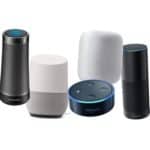Table of Contents
*This post may contain affiliate links. As an Amazon Associate we earn from qualifying purchases.
The Voice Shelf Slowly Replacing The Retail Shelf

“ Voice activated assistants will become a dominant mode of consumer interaction three years from now” are the shocking findings of the Capgemini’ Conversational Commerce Report published in January 2018.
This report also surmised that users of voice command technology will spend 500% more than they currently do through voice transactions.
Currently 16%, thirty-nine million, Americans own a smart speaker. This number is up 128% over prior year. Gartner predicts that 75% of US households will have smart speakers activated by 2020.
This disruptive change to consumerism will have major implications for marketers. The current state of the industry indicates that the technology is in its infancy. As voice assist technology improves, so will conversational consumerism.
Is Voice Assisted Shopping The End of Brands
Potentially good for brands are Google speaker and Android voice. These devices access a Google app that acts as a personal assistant for shopping at a large selection of stores.

Your former shopping preferences, and a pre set-up shopping list, will assist in selecting your favorite brand names. These apps also identify other brand names within a CPG category you request search information on.
Bad for brands may be Alexa and Amazon voice through devices such as Echo.
These devices are owned by an Amazon subsidiary. In its quest to to compete in the world of retail, and maximize profit, these devices direct shoppers to purchase items that drive the highest profit for Amazon.
This video presentation by Scott Galloway, Marketing Professor at NYU, provides a clear focus as to what may be a major financial hit to popular brands, as voice command shopping assistance penetrate US Households.
How Brands Are Finding Their Voice
The future of brands working as partners in the voice activated world is not as doom and gloom as is predicted above.

Brands like Tide and Campbell Soup have created a library of information to share through conversational consumerism
CPG companies are actively developing apps and skills, which are Amazon’s voice driven app on Alexa, to interact with consumers.
These new mediums are providing brands and business an extraordinary opportunity to connect and build a brand relationship with consumers in new ways.
Tide Laundry Detergent developed their stain remover app, where consumers can get conversational advice on how to remove more than two hundred types of stains.
Campbell Soup has created a recipe app, called Campbell’s Kitchen. Consumers chose from a variety of recipes and a the voice app guides one through the step-by-step cooking process. Using voice command technology a conversational experience allows you to stop, go back and make corrections. You don’t have to be alone in the kitchen anymore.
Two Tracks In The Voice Marketing Development Stage
Brands are experimenting with the different ways to use voice technology to increase awareness and sales. There seems to be two tracks to follow as the new media is being navigated.
1. Partnership
Working with platforms like Amazon and Google to be included in a voice search is the first sales track to follow.
Recently the Clorox Company CMO, Edward Reynolds, stated when speaking about Amazon, “We’re hoping they will be as fair about algorithms in voice as they have been in search.”
True to form, Amazon has stated that the best way for a product to be featured in an Alexa shopping search is to have a good product, at a competitive price that ships with Amazon Prime.
In a retail world where brands stood out with package design to get noticed on a store’s physical shelf, there is an entirely new strategy coming together to get noticed on the voice shelf.
2. Communication Commerce
The second track is to use voice technology to increase brand relationships so that shoppers will ask for your product by name.
Similar to the Campbell’s Kitchen and Tide stain removal voice apps, brands are devising unique ways to interact using conversational communication apps and voice commerce techniques.
Burger King Creates a Commotion
In a clever attempt to extend a fifteen second commercial, Burger King’s TV ad asked home viewers Google voice devices to explain what a whopper is.
This ad did not sit well with viewers and with Google. Google took action to stop the connection quickly.
But hey, I’m talking about it here a year after it happened. While the ad technique opens the door to a creepy new reality, it certainly created a lot of attention for a brand that needed a little kick-start.
Target’s Bold Attempt At Voice Activated Coupon
In April of 2018 Target and Google Express through, Google Assistant, launched the first ever voice activated coupon.
The program was a big success. So successful that the promotion was stopped on April 3rd, way short of the scheduled April 21st end date. Target did however honor the coupon codes for consumers that accessed them before the revised cut-off date.
Lesson learned, when access to a coupon offer is as easy as asking for it, and the distribution channel is hard to control, the liability can get out-of-hand.
Kudos to Target for testing the concept and making the retail world pause and recalculate the enormity of the voice medium for sales promotional offers.
Finding Your Consumer Appeal and Voice
The interesting thing about the voice medium is that the technology has a scary ability to build a strong relationship with the user.
As a species we tend to assign human-like characteristics to many interactions. How many people talk to their pets as if they were human? When voice technology answers back, well that takes the interaction to an entire new level.

A recent Speak Easy study of one-thousand smartphone users in the UK found that twenty-six percent of users actually had sexual fantasies about their voice assistant. Thirty-seven percent love their voice assistant so much that they wish it were a real person.
Talk about brand personality.
For the first time in history brands can create an entity to represent them. Will the entity be a host, a presenter, a friend? Will it be a male or female voice? Can the voice be different for different users?
Voice Marketing is indeed a brave new world. As smartphone and household penetration of the rapidly changing technology takes hold, it behoves us all to stay aware and adapt as marketers, and as a species.

